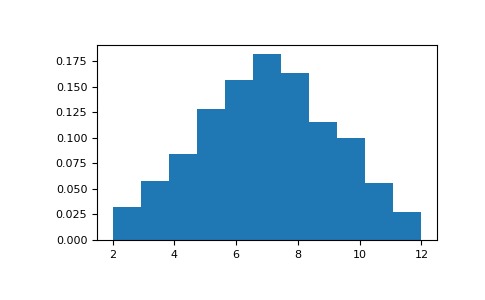用法:
RandomState.random_integers(low, high=None, size=None)np.int类型的随机整数,介于低数和高数之间(含)。
在关闭间隔[low,high]中从“discrete uniform”分布返回np.int类型的随机整数。如果high为None(默认值),则结果来自[1,low]。 np.int类型转换为C长整数类型,其精度取决于平台。
此函数已被弃用。请改用randint。
从1.11.0版开始不推荐使用。
参数: - low: : int
从分布中得出的最低(带符号)整数(除非
high=None,在这种情况下,此参数是最高的整数)。- high: : int, 可选参数
如果提供,则从分布中得出最大(有符号)整数(如果存在,请参见上面的行为)
high=None)。- size: : int 或 tuple of ints, 可选参数
输出形状。如果给定的形状是
(m, n, k), 然后m * n * k抽取样品。默认值为无,在这种情况下,将返回单个值。
返回值: - out: : int或int的ndarray
size-shaped来自适当分布的随机整数数组;如果未提供大小,则为单个此类随机int。
注意:
要从a和b之间的N个均匀间隔的浮点数中采样,请使用:
a + (b - a) * (np.random.random_integers(N) - 1) / (N - 1.)例子:
>>> np.random.random_integers(5) 4 # random >>> type(np.random.random_integers(5)) <class 'numpy.int64'> >>> np.random.random_integers(5, size=(3,2)) array([[5, 4], # random [3, 3], [4, 5]])从0到2.5(含)之间的五个evenly-spaced数的集合中选择五个随机数(即从集合中
):
>>> 2.5 * (np.random.random_integers(5, size=(5,)) - 1) / 4. array([ 0.625, 1.25 , 0.625, 0.625, 2.5 ]) # random将两个六个侧面的骰子滚动1000次并求和:
>>> d1 = np.random.random_integers(1, 6, 1000) >>> d2 = np.random.random_integers(1, 6, 1000) >>> dsums = d1 + d2将结果显示为直方图:
>>> import matplotlib.pyplot as plt >>> count, bins, ignored = plt.hist(dsums, 11, density=True) >>> plt.show()
相关用法
注:本文由纯净天空筛选整理自 numpy.random.mtrand.RandomState.random_integers。非经特殊声明,原始代码版权归原作者所有,本译文未经允许或授权,请勿转载或复制。
